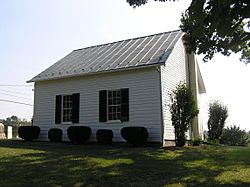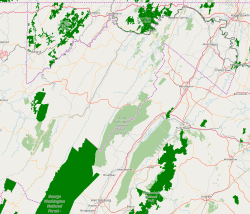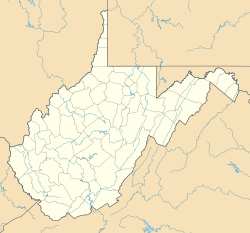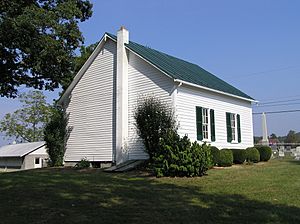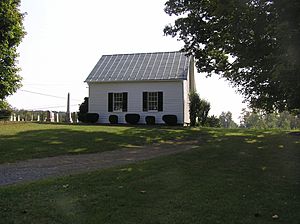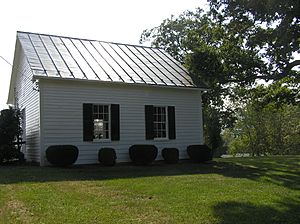Capon Chapel facts for kids
Capon Chapel (pronounced KAY-pən) is an old church near Capon Bridge, West Virginia. It was built around 1852. This church is special because it's one of the oldest log churches still standing in Hampshire County, West Virginia.
Long ago, a group of Baptists started meeting here, possibly as early as 1756. A minister named John Monroe helped set up a place for worship. He is buried in the church's cemetery. The land for the church was given by Joseph Pugh in 1852. He wanted it to be a place for all Christians to worship.
For many years, Capon Chapel was a "union church." This meant different Christian groups could use it. Later, it became a Methodist church. Today, it is part of the United Methodist Church and still holds services.
The church also has a historic cemetery. Many important people are buried there. These include early settlers, a member of the Virginia House of Delegates, and soldiers from the American Civil War. In 2012, Capon Chapel and its cemetery were added to the National Register of Historic Places. This means they are important historical sites.
Contents
Where is Capon Chapel?
Capon Chapel and its cemetery are in southeastern Hampshire County, West Virginia. They are about 2 miles (3.2 km) south of Capon Bridge. The church is close to the Cacapon River, which is where its name comes from.
The church and cemetery sit on a grassy hill. The area around it is mostly farmland. Tall oak trees grow nearby. The church grounds are decorated with boxwoods, a holly bush, and forsythia flowers.
A Look Back at Capon Chapel's History
Early Land and Settlers
The land where Capon Chapel stands was once part of a huge land grant. This grant was given by King Charles II of England a long time ago. Later, a man named Lord Fairfax owned this land.
In the 1730s, English-speaking settlers moved into the Cacapon River Valley. Many came from Pennsylvania and New Jersey. They were often Quakers or became Baptists and Methodists.
Baptist Beginnings
The Baptists were among the first to build churches in Hampshire County. After the American Revolutionary War, Baptist preachers worked to spread their faith. John Monroe was a well-known Baptist minister. He likely started a Baptist church at the Capon Chapel site. Some say a Baptist group met here as early as 1756.
In the 1830s, a new road called the Northwestern Turnpike was built. This helped more people move into the area. A small town grew near the road, which became Capon Bridge.
The land for Capon Chapel belonged to William C. Nixon. He was a member of the Virginia House of Delegates. His mother-in-law was the first person buried in the church cemetery.
While some stories say the church was built in the 1750s, records show it was built around 1852. That year, Joseph Pugh gave the land to three trustees. He wanted them to build "a Graveyard and for a house for the Public Worship of Almighty God for the use of all orthodox Christians." This meant it was for all Christians.
Because no single church group owned it at first, Capon Chapel was a "union church." This means different Christian groups could use it for worship. Baptists used the church until the late 1800s or early 1900s.
Becoming a Methodist Church
Methodists also came to the Cacapon River Valley in the late 1700s. A famous Methodist preacher, Francis Asbury, visited the area in 1781.
In the 1890s, Capon Chapel became part of the Methodist church circuit. A circuit is a group of churches that share a pastor. By the early 1900s, Capon Chapel was mainly a Methodist church.
Today, Capon Chapel is still a Methodist church. It is part of the United Methodist Church. A small group of dedicated people take care of the church and its cemetery.
Keeping History Alive
The church's roof and outside walls were updated around 1900. A special wrought iron fence was put around the cemetery. It was made by a company called Stewart Iron Works.
Electricity was added to the church around 1930. The old stone foundation was replaced with concrete blocks in the 1970s. The beautiful wooden floors were also refinished.
In 2008, people in Hampshire County started a project. They wanted to add historic buildings to the National Register of Historic Places. Capon Chapel was chosen because it's one of the oldest log churches in the county. It shows what rural churches looked like long ago. Capon Chapel was officially added to the National Register on December 12, 2012.
What Does Capon Chapel Look Like?
Capon Chapel is a single-story building made of logs. It has a rectangular shape and a pointed roof in the front. The outside is covered with white wooden siding. The roof is green metal.
Outside the Church
The main entrance is on the east side. It has a wooden door with four panels. Above the door is a small window called a transom window. This window has four glass panes. There are also wooden railings on each side of the entrance.
The west side of the church is plain. It has a chimney made of concrete blocks. On the south side, you can see the concrete block foundation. There are also metal doors that lead to the church's basement.
The north and south sides of the church have two windows each. These are double-hung windows with six panes of glass on top and six on the bottom. They also have green wooden shutters.
Inside the Church
Inside, Capon Chapel has one large open room. Wooden pews (church benches) are arranged in rows, creating a middle aisle. The altar is a small wooden pulpit where the speaker stands. It has a decorative wooden background.
The walls inside are covered with wooden panels and wallpaper. The ceiling is a "dropped ceiling," which hides the electrical wires and old chandeliers. Before electricity, people used kerosene lanterns for light. Some of these old lanterns are still in the church for decoration. The floor is made of original wide pine planks.
The Cemetery
The cemetery is right next to the church on the east side. It's less than an acre in size. A beautiful wrought iron fence surrounds it.
As of 2012, about 270 people are buried here. These include:
- John Monroe, the early Baptist minister.
- William C. Nixon, a member of the Virginia House of Delegates.
- Captain David Pugh, another important local leader.
- Veterans from the American Civil War, both Union and Confederate soldiers.
- Free and enslaved African Americans.
- Gertrude Ward, a local historian.
Older gravestones are made of limestone. Newer ones, after 1900, are made of polished granite. Many of the old gravestones have worn down over time. Important leaders have more fancy gravestones. For example, Captain David Pugh and his family are buried under a large obelisk (a tall, pointed stone monument).
The wrought iron fence around the cemetery is about 4 feet (1.2 m) tall. It has decorative arrows on top of its posts. The gate even has a shield that says, "The Stewart Iron Works, Cincinnati, Ohio," showing where it was made. A newer part of the cemetery, added around 1990, is surrounded by a chain-link fencing.
See also
 In Spanish: Capon Chapel para niños
In Spanish: Capon Chapel para niños


